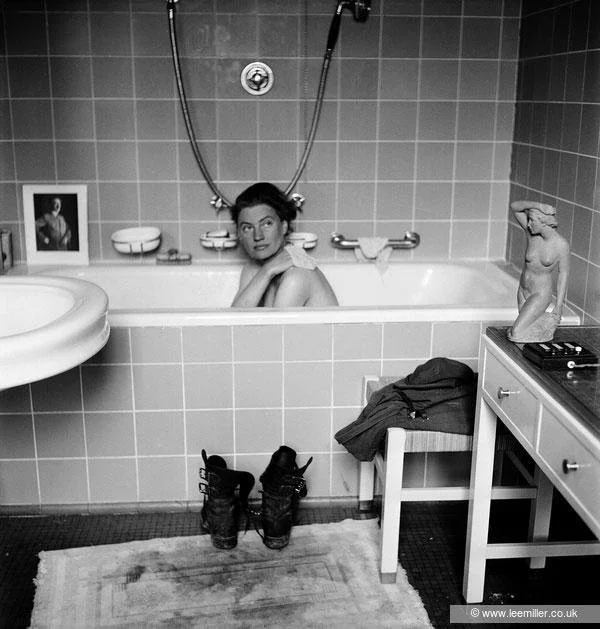Lee Miller
On April 30, 1945, the photojournalist Lee Miller took a bath in Hitler’s tub. A correspondent for British Vogue, Miller had posted up in the Führer’s abandoned apartment in Munich along with a group of G.I.s from the 179th Regiment. That morning, she had been among the first to enter the newly liberated Dachau. At Hitler’s residence, before climbing into the tub, she set up her camera; her lover at the time, the Life photographer David Scherman, took a shot as she bathed. In time, the picture would become famous as a kind of apt visual metaphor for the end of the war. The same day, across Germany in a Berlin bunker, Hitler and his new wife, Eva Braun, took their own lives. In a letter to her Vogue editor, Miller described Dachau’s “great dusty spaces that had been trampled by so many thousands of condemned feet—feet which ached and shuffled and stamped away the cold and shifted to relieve the pain and finally became useless except to walk them to the death chamber.” In Scherman’s photograph, some of that same dust has tracked from Miller’s boots onto Hitler’s white bathmat.
……
Scherman’s photograph of Miller in the tub is not exactly glamorous. She does not seem like one of the prototypical bathing beauties who populate art history, like the one carved in stone, or perhaps cheaply reproduced in plaster, that is sitting on the dressing table to her right. (Miller later offered her withering assessment of the Führer’s collection: “The art work—sculpture, still wearing prize medals from exhibitions on a string—was mediocre, as were the paintings on all the walls.”) She is still beautiful, modestly hunched over and scrubbing her upper back with a washcloth, but she looks tired. At Dachau, that morning, she had photographed piles of bodies in trucks and train cars, which had escaped incineration only because the camp had run out of fuel five days prior; skeletal prisoners still warehoused in their bare bunks, too weak and sick to celebrate their freedom; an S.S. guard, unjustly placid in death, floating in a canal. Only about a third of her negatives from that April morning survived, because Miller visited the Vogue offices and went at many of them with a pair of scissors. A darkroom assistant at the time later recalled Miller saying, “I don’t want anyone to have to see what I witnessed, but I’m leaving enough to make sure there’s no doubt about what happened.”
On Day 6 I’ll be visiting Dachau and I’ve been trying to decide if I want to actually go in. Walking into the House of Terror in Budapest, a wall of televisions lined the entrance hallway with people telling their stories of the horrors they experiences within the walls of that building. I could hear old men crying as they spoke and I immediately turned around and left. My heart couldn’t handle the experience. The wailing still haunts me.
I’ve never been anywhere like Dachau. I’ve been to internment camps, we have one in my home town that turns into the state fair every year. I had my high school graduation there. I visited Manzanar in California a few weeks before my husband and I decided to divorce, so that’s a fun memory. Reading through Reddit today there was a post about the upcoming movie “Lee”, based on the war photographer Lee Miller. The image Miller is known for is her in the bathtub of Hitler after photographing the liberation of Dachau, the dirt still on her shoes from the camp, staining his white bathroom rug. He killed himself later that day. This led me down a path of research and with the memory of the dust that I found for years on my shoes after my trip to Cambodia on my mind, I’m not surprised that I’m now interested in visiting this horrible place.
More reading and listening here:
https://www.newyorker.com/culture/photo-booth/when-lee-miller-took-a-bath-in-hitlers-tub
https://www.bbc.co.uk/sounds/play/w3ct4x9p
https://www.artandobject.com/news/annie-leibovitz-recreates-lee-millers-famed-image-hitlers-bathtub
